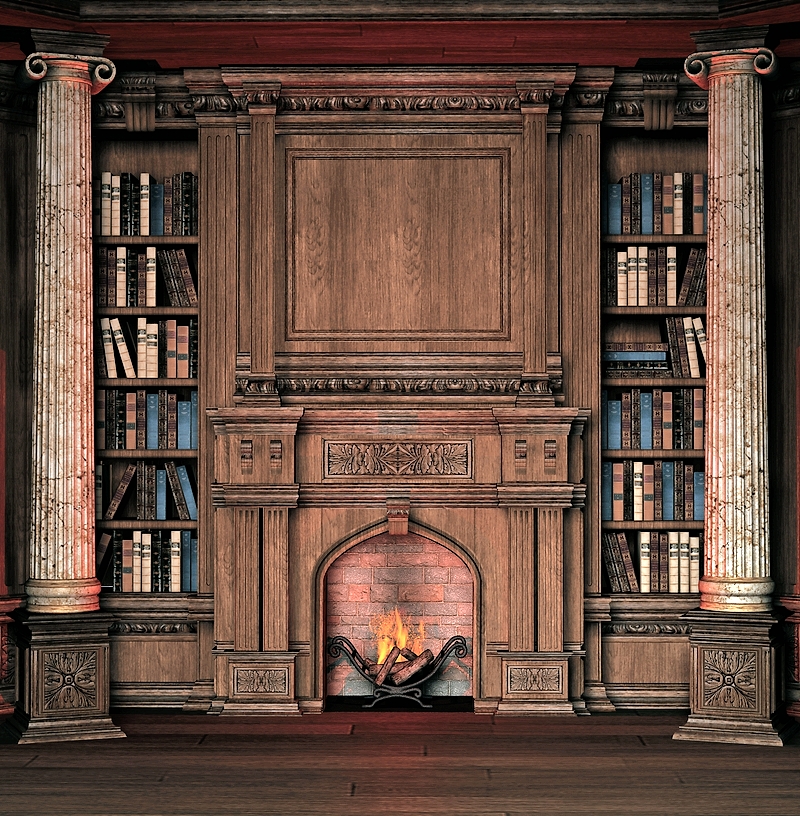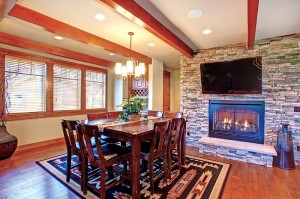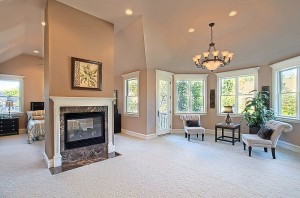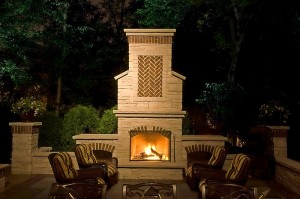Warm Nights, Cool Fireplaces—Fireplace Styles Give Naperville Homeowners Options
By Karen Dix
September 2014 View more Featured
 From the Stone Age to today, gathering around a toasty fire has always been a popular activity for friends and family. While the home fireplace was once a necessity for heating and cooking, today’s fireplaces are a beautiful way to create a warm and welcoming ambiance in any home.
From the Stone Age to today, gathering around a toasty fire has always been a popular activity for friends and family. While the home fireplace was once a necessity for heating and cooking, today’s fireplaces are a beautiful way to create a warm and welcoming ambiance in any home.
Fireplace 101
The oldest and most traditional kind of fireplace is the wood burning, which requires a masonry chimney, a supply of wood and careful tending by the homeowner. While there is some controversy over the environmental effects of wood burning, some believe there is no substitute for the charm of natural flames dancing to the crackle and hiss of the spreading fire.
Gas-powered fireplaces rose to popularity in the 1980s with the invention of direct vent fireplaces and they are still a popular and efficient choice today. Gas fireplaces require a gas line source. Direct vents safely and efficiently contain the fire behind glass, are easy to install, and can be turned on or off with the flip of a switch or the button of a remote. Only the fire’s heat, not exhaust or fumes, vent into the room.
The electric fireplace produces heat through electricity and can cost significantly less to operate than a gas fireplace. They can be mounted on a wall, like a piece of art, but to some, the fire effects look less authentic. Nevertheless, electric fireplaces have the unique advantage of portability. When the homeowner moves, they can just take the electric fireplace off the wall, hang it up and plug it in at their next house.
Finally, the gel-burning fireplace can be placed anywhere and requires a constant supply of canned gel fluid, which must be lit by the homeowner. Gas logs lay over the gel light for a natural effect.
 So, just how important is it to have a fireplace in your home today? Of the homes sold in Naperville over a three-month period, 95 percent had fireplaces, and their average selling price was approximately $75,000 more than the average selling price of a home without a fireplace, according to Realtor Vickie Schoenfeld from Baird & Warner. “At a certain price point, home buyers expect to see them, but it’s a matter of preference as to what they want to see,” she said. “One client was thrown off by a house I showed that had a gas-powered instead of a wood-burning fireplace. They wanted the wood.”
So, just how important is it to have a fireplace in your home today? Of the homes sold in Naperville over a three-month period, 95 percent had fireplaces, and their average selling price was approximately $75,000 more than the average selling price of a home without a fireplace, according to Realtor Vickie Schoenfeld from Baird & Warner. “At a certain price point, home buyers expect to see them, but it’s a matter of preference as to what they want to see,” she said. “One client was thrown off by a house I showed that had a gas-powered instead of a wood-burning fireplace. They wanted the wood.”
Fireplaces are a significant investment that some homeowners are willing to make, with new construction costing up to $10,000 depending on the cost of the fireplace itself, installation costs (such as gas lines), hearth and mantle materials, and masonry.
Fire, Fire Everywhere
Builders say homeowners are installing additional fireplaces throughout the house. “I put fireplaces in 100 percent of the homes I’ve built and I don’t recall a customer that has only done one fireplace,” said David Huber of Huber Homes, LLC, a Naperville boutique homebuilder. Huber recently worked on the construction of a new house with six fireplaces, including a hearth room fireplace off the kitchen, one in the family room, the lower level, the master bedroom, the study, and the outside yard. The study and outside fireplace back up to each other and share a masonry chimney.
Direct vent gas fireplaces make fireplace installations easy. Jean Klinker, a designer at Reliable Home Improvement, says she gets requests for and includes more direct vent, gas fireplaces in typical room remodels, especially in the lower level and the master bedroom. “Direct vents can be placed in a frame and are much less expensive to install for a remodel than a new masonry fireplace. It’s a more contemporary look, but is quite popular now,” she said. Some even have features like timers, so your romantic master bedroom fireplace can automatically extinguish itself once you fall asleep.
Restyling the Fireplace
For homeowners who already have a masonry or brick fireplace, a popular way to update it is to reface it. “People today want to cover up their brick with natural stone,” said Greg Hopkins, owner of A Cozy Fireplace. His spacious showroom displays a number of natural stone options suitable for fireplace surrounds. Hopkins said these days customers are clamoring for linear designs featuring natural stone cuts from rocks like slate that are laid on top of each other horizontally. “Anything without mortar lines is ‘in’ right now,” he said.
For the fireplace hearth, Klinker is noticing a trend away from the traditional raised hearth, with homeowners instead requesting fireplaces that are flush to the ground with natural stone hearths out of polished or honed granite. “Without the raised hearth, people can arrange their furniture closer to the fire,” she said.

Photo courtesy of Huber Homes
Another modern, contemporary trend is the linear design fireplace. With the advent of gas, and the many sizes of fireboxes available, Klinker says a large space is no longer necessary to install a fireplace. “If you have a small space, you can find a fireplace that you can fit in it,” she said. “Some fireplaces are meant to be part of the wall, like a centerpiece. They can be tall and narrow or very horizontal.” Klinker has done designs with two-sided, see-through direct vent fireplaces installed into a wall at eye level and three-sided peninsula structures to house the fireplace. Often, homeowners accent the fire with a bed of colored, cut glass to coordinate with the room’s décor.
Hopkins’ store, which sells the majority of its fireplaces to builders, said nearly 70 percent of his sales are gas fireplaces, although electric fireplaces are currently outselling wood burning, because of their efficiency and convenience. “When gas prices rise, however, we sell more wood-burning fireplaces,” he said.
Above the Flame
The mantle is the crowning touch on a traditional fireplace or absent on contemporary ones. Mantles can be part of an ornately carved stone or wood frame cascading to the ground, or a “floating mantle” that sits above the fireplace and showcases family photos or other decorative items. Today, though, more and more televisions are taking the place of family photos above the mantle.
“Mounting the TV above the mantle is a great way to save space in the room,” said Klinker. “But you have to make sure you have seating far enough away that it is easy to see the television. Also, you would want a stone mantle rather than a wood, since it can be placed closer to the firebox and add extra protection for the TV.”

Photo courtesy of C.B. Conlin Landscape
Fire Outside
With the many weatherproof options available for electronics nowadays, the TV can also be found above the fireplace mantle – outside. “There is definitely a trend toward elaborately furnished outdoor living areas and moving from a fire pit to a fireplace,” said Huber. For the outdoors, clients favor a wood-burning, masonry open chimney that is both beautiful as well as functional. Huber has clients that enjoy the Bears games in comfort on the outdoor television for the entire the season, kept toasty warm by the roaring fireplace.
Inside or outside, gas or wood, the trends and options for fireplaces continue to grow and change. That is good news for today’s homeowner, whose continued fascination with the fireplace, is undoubtedly here to stay.


